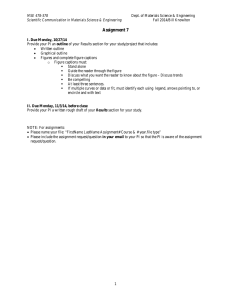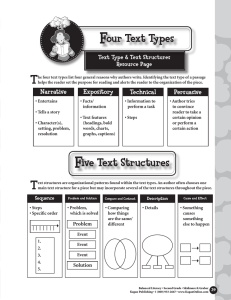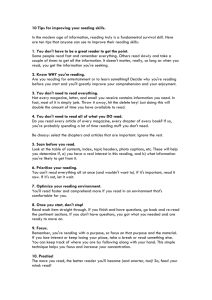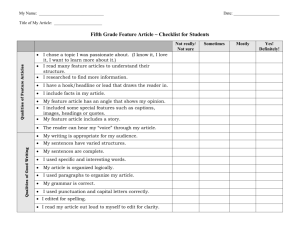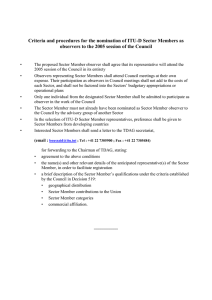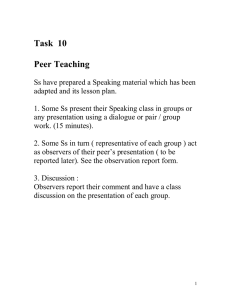Laboratory Reports - Center for Neural Science
advertisement
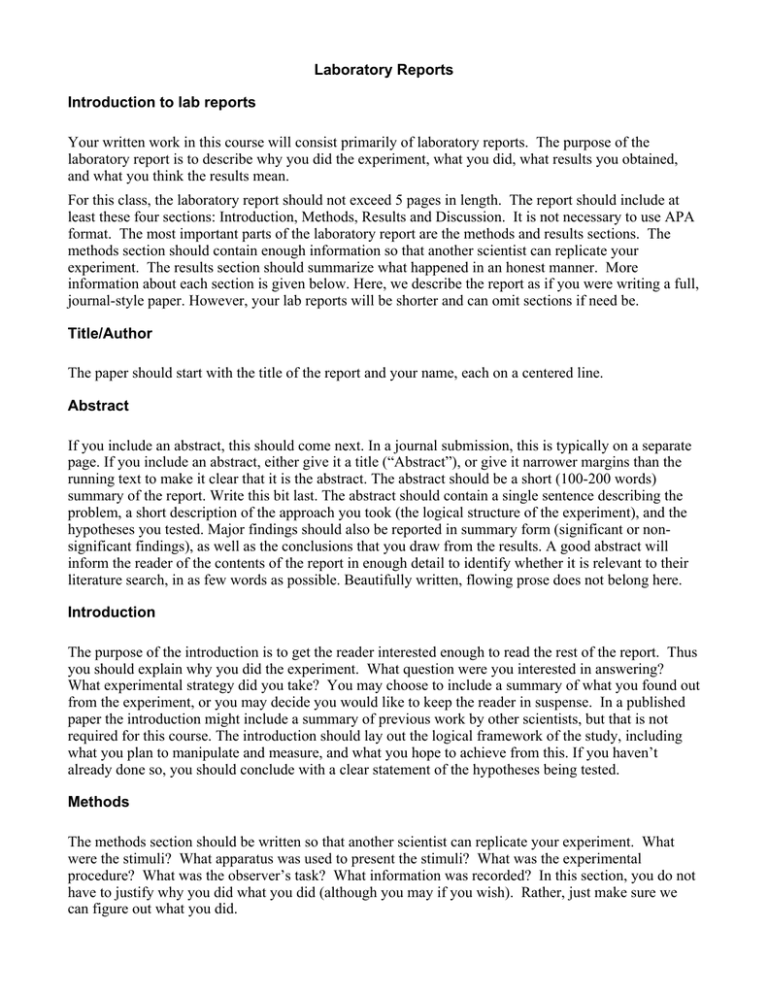
Laboratory Reports Introduction to lab reports Your written work in this course will consist primarily of laboratory reports. The purpose of the laboratory report is to describe why you did the experiment, what you did, what results you obtained, and what you think the results mean. For this class, the laboratory report should not exceed 5 pages in length. The report should include at least these four sections: Introduction, Methods, Results and Discussion. It is not necessary to use APA format. The most important parts of the laboratory report are the methods and results sections. The methods section should contain enough information so that another scientist can replicate your experiment. The results section should summarize what happened in an honest manner. More information about each section is given below. Here, we describe the report as if you were writing a full, journal-style paper. However, your lab reports will be shorter and can omit sections if need be. Title/Author The paper should start with the title of the report and your name, each on a centered line. Abstract If you include an abstract, this should come next. In a journal submission, this is typically on a separate page. If you include an abstract, either give it a title (“Abstract”), or give it narrower margins than the running text to make it clear that it is the abstract. The abstract should be a short (100-200 words) summary of the report. Write this bit last. The abstract should contain a single sentence describing the problem, a short description of the approach you took (the logical structure of the experiment), and the hypotheses you tested. Major findings should also be reported in summary form (significant or nonsignificant findings), as well as the conclusions that you draw from the results. A good abstract will inform the reader of the contents of the report in enough detail to identify whether it is relevant to their literature search, in as few words as possible. Beautifully written, flowing prose does not belong here. Introduction The purpose of the introduction is to get the reader interested enough to read the rest of the report. Thus you should explain why you did the experiment. What question were you interested in answering? What experimental strategy did you take? You may choose to include a summary of what you found out from the experiment, or you may decide you would like to keep the reader in suspense. In a published paper the introduction might include a summary of previous work by other scientists, but that is not required for this course. The introduction should lay out the logical framework of the study, including what you plan to manipulate and measure, and what you hope to achieve from this. If you haven’t already done so, you should conclude with a clear statement of the hypotheses being tested. Methods The methods section should be written so that another scientist can replicate your experiment. What were the stimuli? What apparatus was used to present the stimuli? What was the experimental procedure? What was the observer’s task? What information was recorded? In this section, you do not have to justify why you did what you did (although you may if you wish). Rather, just make sure we can figure out what you did. Psychology 0044 Lab Reports Page 2 Methods sections should be written clearly, and all pertinent details should be included. A good test of a methods section would be to hand the paper to a colleague who has no prior exposure to your experiment, and ask them to describe, in detail, how the experiment was carried out. If their description is in agreement with your experience, then you know you have the words right. Typically, a methods section is broken down into a number of subsections. These may include stimuli, apparatus, design, procedure and observers, and many other important pieces of information, such as how the monitor was calibrated, how participants were recruited and selected, etc. In our lab reports, we are going to follow the example of visual psychophysics and include sections for stimuli, procedure and observers. We generally don’t use much in the way of apparatus, so that information can be included in with the stimuli. We don’t have anything against experimental design either, but our experiments will tend to be simple designs, where one observer carries out all conditions, rather than the more complex multi-group designs of cognitive and social psychology. Stimuli First of all you want to describe the basic form of the stimulus. A figure here may help to illustrate the visual stimuli, and this is a good place to put it, if it wasn’t already covered in the Introduction. Identify those parts of the stimulus that can change from trial to trial, and report which values were used. Describe the equipment, stimulus size, duration, and all other details (see the handout “Specifying the Visual Stimulus”). Procedure This is generally the toughest part, and it helps to break it down into short paragraphs. If applicable, start by identifying the psychophysical method you used (e.g. method of adjustment, method of limits, etc.). Next, you should describe events within a trial. More specifically, what happened, in what order, for how long (or whatever the relevant factors are), and what was the observer’s task? Be sure to let the reader know what information was recorded. In other words, what was the dependent variable? Next, you should explain how the trials were put together. Often this is done in ‘blocks’ of trials for longer experiments. What were the differences between the trials, and what was done to the stimulus? In other words, describe the independent variable(s). It’s also nice to let people know how long each of these ‘blocks’ of trials lasted. Finally, how were the different blocks of trials put together across the experiment? Again, this is another opportunity to divulge the independent variable or experimental manipulation, if you haven’t already done so. Observers Here you describe the participants. There’s so much you could say, but much of it is irrelevant. Typically, you could make do with the following: how many observers? Were they the authors of the report, other vision researchers / graduate students, or were they naive as to the purpose of the experiment? How was their vision (normal, or corrected-to-normal)? It is also customary to mention if observers were paid. In some cases, it’s also important to describe how the observers were recruited, especially if they represent a specific target population (e.g. the elderly), or you wish to generalize the results. Also, you should never refer to an observer (other than yourself) by name. One of the requirements of Internal Review Boards (IRB’s) and funding agencies is concerned with the protection of participants’ anonymity. If you need to identify different observers, use a two- or three- letter code name. In vision research, though, it is customary to use the observers’ initials, with their permission of course. Psychology 0044 Lab Reports Page 3 The suggestions above are not exclusive. There are many excellent papers that might seem to ‘break the rules’ listed above, or include other things I haven’t mentioned. If in doubt, include the information, and let the readers sort out what’s relevant and what isn’t. The major criteria are to adequately describe the stimuli, task, measurements/dependent variables, and the independent variables and their levels. Results What were the results? This section should let us know what happened, including the results of any statistical tests. Graphs are highly recommended. Try to graph the data in such a way as to clarify for the reader the features of the data you think are most important. In addition to providing summary measures (such as the mean), provide some measure of the variability of the data (typically in the form of error bars derived from the standard error of the mean). You may also wish to include tables of the data or statistical analyses. You also need to include a written description of the results as they appear on the figure. You should also discuss what you think the data mean. In general, a results section will contain the data, including a description of the major findings, and any trends observed. Raw data is often clumsy and boring, and most authors (and readers) prefer the data to be summarized in the Results section. First of all, you need to explain what is being presented (means, thresholds, difference scores, etc.), and how they were obtained from the raw data. It’s okay to tell the reader that the data are means and assume they know what a mean is, but you should include things such as how the data are grouped, how many observations are included in each mean, whether data are averaged across observers, and the like. There are two broad classes of statistics: descriptive statistics and inferential statistics. Descriptive statistics are a way to summarize data, and these include averages (mean, median & mode), range, standard deviation, standard error (often used in error bars) and so on. You should describe the data in terms of central tendency (average), and dispersion (range, standard deviation etc.). Never assume that the reader will bother looking at your beautiful figures unless you refer to them in the text, and point out the key features you want the reader to observe (“Weber fraction increases as a linear function of the weight of the standard”, for example). A general rule of thumb is to read your paper without including the figures, and see is you are still able to get the main points across. Inferential statistics are calculated measures such as t-scores or F-statistics that allow us to compare the data with established probability distributions or tables in order to test hypotheses. The statistical test you use will depend on the hypothesis and the type and organization of the data, but there is a general form for the results of tests. For example: “Müller-Lyer comparison stimuli were judged as significantly shorter than the standard length (t=5.68, df=9, p<.01, one-tailed test).” For an ANOVA, the corresponding statement would be something like “There was a significant effect of stimulus type (F(1,59)=17.24, p<.05) and set size (F(3,59)=19.56, p<.01), but there was no significant interaction (F(3,59)=1.96, NS).” Discussion In the results section, you described the data, and included the results of the statistical tests without judgment or commentary. In the discussion, you get to interpret your findings. Don’t simply restate the results, but relate the results to the hypotheses stated in the Introduction. Explain what implications these results have for the theory you may have proposed earlier, or other people’s theories. Did the results answer the question you set out to answer? (If the results are ambiguous and do not allow you to draw any firm conclusions, state this rather than trying to “get the right result”. In this course, we will Psychology 0044 Lab Reports Page 4 not penalize very much if your experiment did not “work”, as long as your basic design was sensible and your report clear.) You can also use the discussion section to revisit the logical framework in the Introduction, and modify or extend it. A lot of the time you will be able to suggest further areas of study which might help enlighten a particular problem you have identified, or simply identify questions which need to be answered. If you think of problems or shortcomings in your study, feel free to critique your own work here. We do this all the time in science, mostly because otherwise someone else will do it for you, and make you look like you hadn’t thought of it first. Once again, there aren’t any specific rules for a discussion, just an opportunity to continue the discourse you started in the Introduction, but in light of the new results you obtained. References Every time you report someone else’s work, you give them credit in the text by referencing the author(s) and the year of publication (e.g., Campbell & Robson, 1968). In the reference list, you give the full description of each source you cited, listed alphabetically by author. It looks nicest if you start each line without an indent, but indent subsequent lines of references longer than one line. Single-space individual references, but leave a blank line between each reference. See earlier handouts for examples. If you don’t have any references, you will omit this section. Table Captions / Figure Captions These have a section of their very own. List them in order, all the table captions first, then all the figure captions. See the handout on graphs for how to write captions. Tables and figures and their captions In a typical journal submission, the references section is followed by a section giving the figure and table captions (each in order by number). Then, the tables and figures go at the very end, in the same order as the captions. Nothing should be written on them except for the figure/table number. When you first refer to a figure or table in the main text, insert a box conveniently between two nearby paragraphs which says, for example: ______________________________________________ INSERT FIGURE 3 ABOUT HERE ______________________________________________ However, in your lab reports, you may also choose to include the figures in the running text at the point at which they are cited. In this case, put the figure or table number and caption below the corresponding figure or table. Make the caption distinguishable from the running text (e.g., by using a smaller type size and/or narrower margins). Header/footer and formatting Please include either a header or footer for your paper that includes your name and a page number. You can set it up to skip the header/footer on the first page if you so choose. All papers should be doublespaced (except for the references section as mentioned above).

